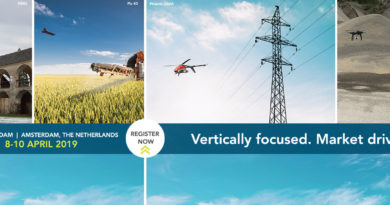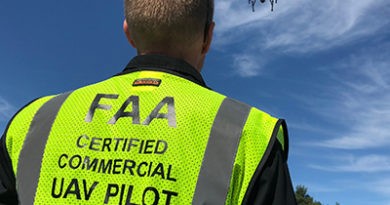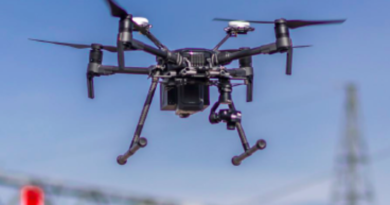Data Visualization and Analytics: Q&A with Jan Wouter Kruyt of Propeller Aero
![]()
With so many developments rapidly progressing in the drone industry, it can be hard to keep up with all the new companies and what it is they offer. This Q&A with one of the leading data visualization and analytics providers is intended to demonstrate the broad applications of drones in various industries, and how they are being used to make the world a better, more efficient and productive place.
What is Propeller Aero? What types of industries is your software/hardware most ideally suited for?
Propeller Aero is a drone data visualization and analytics company that makes software for high-accuracy GPS drone surveying and a hardware product called AeroPoints, which are smart ground control points that gather accurate data from UAVs. Propeller Aero’s solutions track large areas of land and earthwork operations, as well as increase worksite safety and efficiency, for surveyors and contractors across construction, mining, aggregates, and waste management industries. A global leader in cloud visualization and analytics solutions, Propeller Aero gives worksites the power to measure and manage themselves.
Can you give an example of how the data and analysis process would work on a specific project? (How it helps save time, money, resources, create safer environment, etc.)
Propeller understands the value of long-lasting, mutually beneficial partnerships, which is why it is dedicated to the success of all of its customers. One example of Propeller’s tangible worksite improvements can be found in the company’s work with Cheshire Contractors, a mid-sized construction company. Looking for better insight into dirt movement on their sites to gain a complete understanding of who was moving what dirt, where, and when, Cheshire partnered with Propeller to increase transparency of site conditions and reduce time spent in the field surveying. As a result of the partnership, Cheshire has saved a significant amount of time (more than 15 days) and money (nearly $20,000) on one project alone.
In other case studies, Propeller’s platform has produced a 90% reduction in time spent measuring and processing site data; 50% increase in net-profits; and 75% survey cost reduction.
What is unique about Propeller in comparison with other similar worksite data products on the market?
Propeller is a solution that solves businesses’ problems without creating more. Customers appreciate Propeller’s easy-to-use solution that doesn’t require dedicated staff, computers, or training.
The platform is built completely in the cloud, allowing Propeller’s processed site data to be easily shared and accessed anytime, anywhere. Propeller also offers drag-and-drop local site calibrations, a feature most competitors overlook.
Propeller offers measurements in full 3D, including cut/fill maps, take-off maps, cross sections, visual timelines, and contours. Offering drones, flight planning apps, GCP systems, and processing software that flexibly integrates with other systems, Propeller gives customers the flexibility to grow however they decide.
How was your reception/response at INTERGEO last month? Any standout takeaways/developments from the expo?
Just like last year, INTERGEO was a great opportunity for us to meet with existing and new partners, especially as we are currently building out our presence in Europe. Every INTERGEO edition, it becomes more clear what the geospatial community desires from drone surveying and it’s great to see that the hype around flying robots has been replaced by valuable results obtained by customers in the field.
It was especially cool to see drone manufacturer DJI, one of Propeller’s key partners, take the stage in Frankfurt to launch the new drone: the Phantom 4 RTK. The Propeller platform offers a seamless PPK (post-processing kinematic) workflow using this drone and 1 AeroPoint as a base station. The ease of use and the price point of this PPK workflow will put 3cm-accuracy drone surveys in the hands of a much wider group of users in industry. It addresses the key concerns our customers have when using drones for surveying: further reducing time spent on setting up ground control, validation of model accuracy, and cost of the drone. We are convinced it’s a game changer.
What developments are in the works for your company? How do you anticipate growing to meet demand and improve over the next few years?
The next few years will be incredibly exciting as we look to integrate further with the key players in construction, mining, aggregates, and waste management. We will continue our focus on these tightly integrated industries, helping them move to a more and more efficient, digital workflow. We have some very exciting developments coming to help our customers measure and manage their worksites using dead simple high-tech.
Anything else you would like to add?
As Propeller has taken on earthmoving industries’ digital transformation, the company’s progress has paid off. Over the past year, Propeller has opened its North American headquarters in Denver, announced $10M in Series A funding, and more than doubled its employee headcount. Today, Propeller is used on over 14,000 worksites in 120 countries in order to deliver more than 55,000 worksite surveys for industry-leading companies.
- Data Visualization and Analytics: Q&A with Jan Wouter Kruyt of Propeller Aero – November 7, 2018
- End-to-End Drone Mapping Solutions – Q&A on eBee X and ANAFI Work – October 29, 2018
- 3D Sensing Solutions – Q&A with Cepton Technologies – October 26, 2018
- Would You Rather: Race a Car or Race a Drone – July 18, 2018
- A Modern Take on Drone Insurance – July 9, 2018




